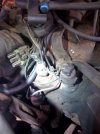The pcv valve should be going into the other valve cover. Opposite the breather. If you pull it out while the engine is running (mind the fan blade!) , you should have decent vacuum pull there. If you take it out of the hose, the little ball inside should rattle freely. Was this an engine swap? I see the weather pac connector (with the green gasket) with the three unplugged spots in the photo, and I didn't think GM started using that connector until later on.
Those both look like temp senders, one could be for the light on the dash. More than likely the sensor with one wire goes to the dash. Follow the wires and see if the other one sends a wire to the carb.
You say the choke plate was vertical with a cold engine? And it starts right up? Kinda a tough month to test the choke, with warmer temperatures, but if it doesn't choke the car at all with the engine cold, it could be a problem. However, if the choke stays wide open once the engine is warmed up, it might be working fine. What position is the choke in when the engine dies? I've had carter 2 barrels that would get the choke closed, then die. Even with a warmed up engine. The only way to get them started again was to prop the choke open partially with a screwdriver or pair of pliers (something that wouldn't fall in!).
Is it possible that someone messed with an idle adjustment screw or main throttle plate stop screw to get it to start? I've seen this before, where people compensate for a broken choke by letting more fuel through an idle adjustment, then cutting the idle RPM back down by screwing up the throttle stop. The car then starts, and idles, but is a dog off the line, and generally runs too rich. You say that when the car dies, you have to give it gas to get it going again. Does it start ok if you push the pedal to the floor? Or do you HAVE to pump it? Opening up the throttle plate, and getting a breath of fresh air into the engine helps if it was getting flooded by an overly rich idle adjustment. This can be really frustrating, because people can only get the car to start by pushing the gas pedal, which leads them to think the car isn't getting enough gas. When in actuality, it needs fresh air to work the rich condition through the cylinders.
BTW, a messed up carb running rich WILL plug the catalytic converter. I don't buy the "cat has a hole in it" theory. Unless someone cut the darn thing off the car, you can't tell that. Unless he was talking about a rusted out hole on the outside, and with that you would heard the exhaust leak.
I think it is time to take this car to someone with a few basic diagnosis tools. Vacuum gauge, multimeter, fuel pressure gauge, spark tester, timing light. If you can find someone with just a few basics, you can go a long way to keeping this car running.

